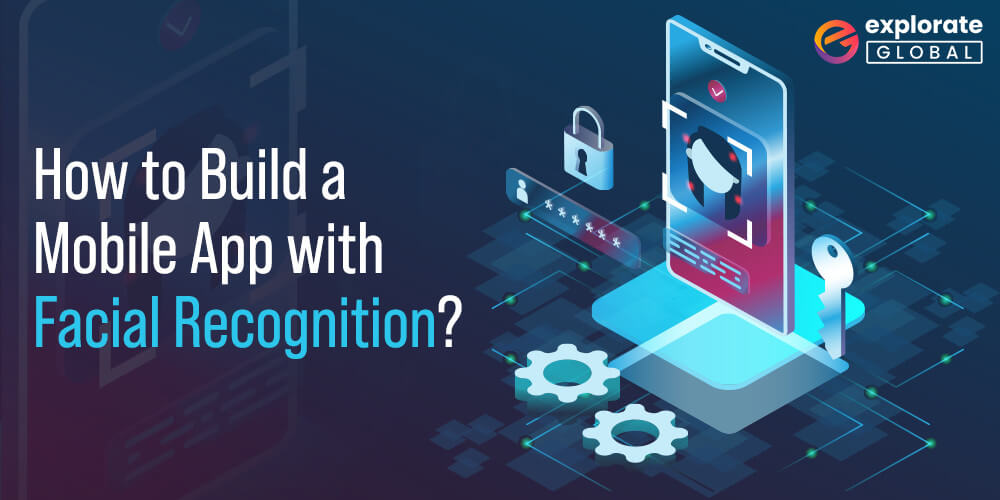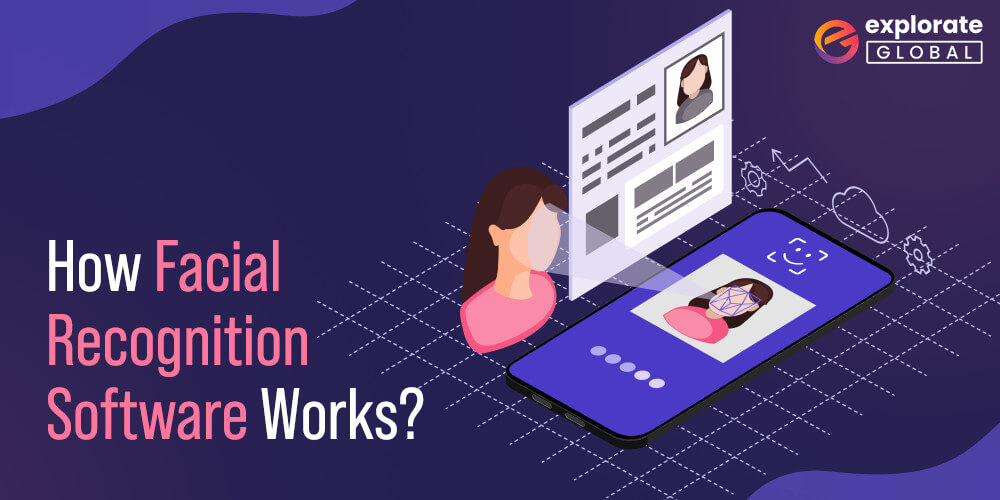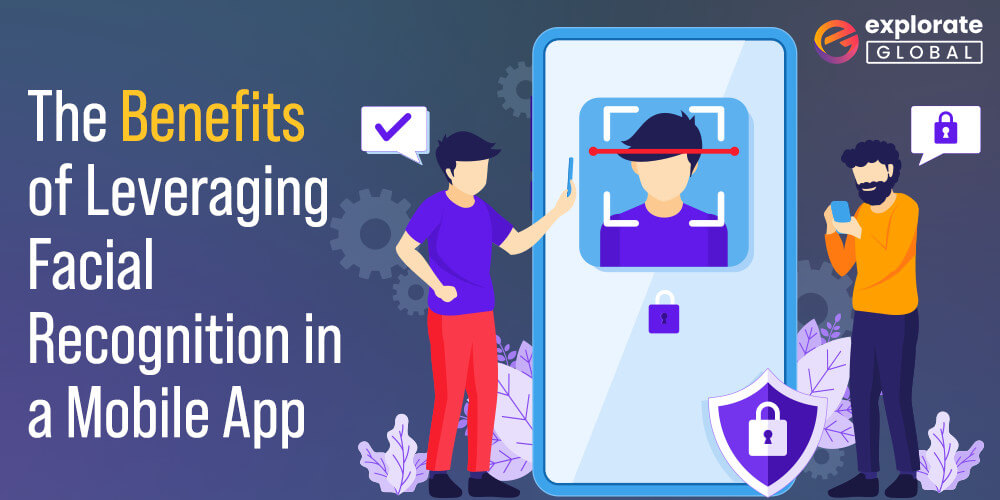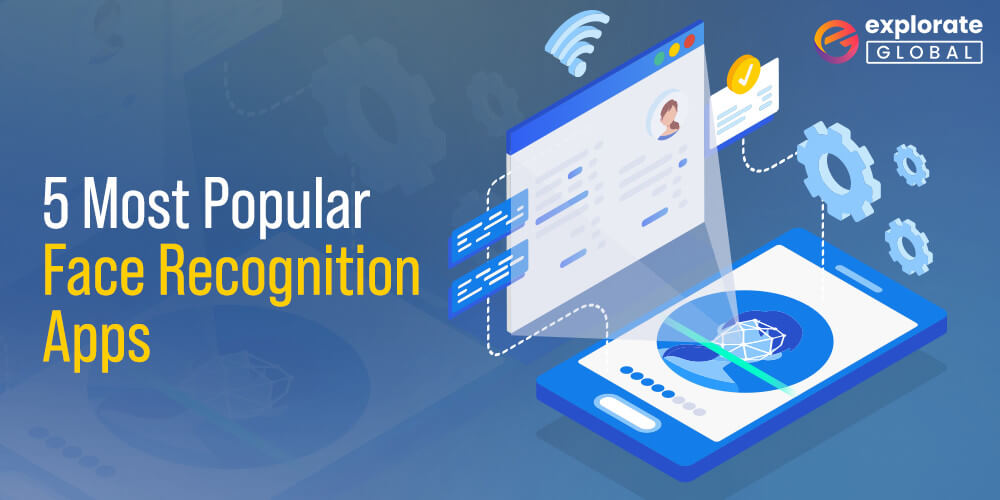
The app that recognizes faces no longer sounds like a dream. Thanks to the expansion of innovative technologies, dreams are disappearing one after another from our lives and becoming common in everyday occurrences and it’s not so bad since in return we get a chance to benefit from these remarkable achievements. This also applies to facial recognition software. However, the area is still new and evolving, but several companies have already managed to achieve profit from it. That’s why the digital market is flooded with popular face recognition mobile apps which have fascinated numerous reliable users and started making good profits.
Facial recognition is a software that maps, evaluates, and then confirms the individuality of a face in a photograph or video. This is one of the most influential and powerful surveillance tools ever made. While most people interact with facial recognition simply as a way to unlock their phones or sort their photos, but how companies and governments use it will have a larger influence on people’s lives. As per the recent analysis by Bloomberg, by 2022, the global facial recognition market will have expanded to 7.76 billion US dollars from 4.05 billion dollars in 2017. Well, the trend looks promising, right?
Today, this technology finds a lot of applications not only in the field of security (for example, searching for criminals from surveillance cameras in real-time, or the recognition of airline passengers) but also in our everyday life. Another example comprises searching for people from photos on Facebook, grouping images in Google Photos face recognition, unlocking smartphones with a face, etc. Although this operation involves vast computing power and was initially priced high to keep up with this requirement, now such functionality is reasonable and accessible to everyone. Building a custom face recognition app for iPhone and Android is no longer problematic from a budget or functional perspective.
What is Facial Recognition Technology?
Facial recognition is a biometric software feature that is capable of exclusively recognizing or verifying an individual by comparing and calculating patterns based on facial contours. Facial recognition system is commonly used for security purposes, although there is growing interest in other areas of use as well. In fact, facial recognition technology has established noteworthy consideration as it has the prospective to be leveraged in an extensive range of applications.
Facial recognition includes recognizing someone using the appearances and features of the face using several technologies, which include 3-D, vascular and heat-pattern, and skin texture analysis. In the most prevalent type of facial recognition, algorithms recognize certain points on the face and create a template for that person. It turns out to be most accurate when users voluntarily submit their images into a limited database. When the individual moves towards a facial recognition scanner, their live face image is captured and transformed into a template, which is then compared and matched to the templates stored in the database. A match allows the user to undertake the desired activity, such as passing through a door or logging into a computer network, etc.
A Brief History of Facial Recognition
The origin of facial recognition was shaped in the 1960s when Woodrow Wilson Bledsoe established a system of measurements to categorize photos of faces. A new, unidentified face could then be compared against the data points of previously entered photos. The system wasn’t as fast as modern standards, but it proved that the idea had quality. By 1967, interest from law enforcement was already creeping in, and such organizations seem to have supported Bledsoe’s continued research, which was never published into a matching program.
Throughout the ’70s, ’80s, and ’90s, new methods with attractive names like the “Eigenface approach” (PDF) and “Fisherfaces” enhanced the technology’s capability to detect a face and then recognize features, paving the way for modern automated systems. Facial recognition’s first intense shift to the public stage in the US also brought on its first huge controversy. In 2001, law enforcement officers used facial recognition on crowds at Super Bowl XXXV. Critics called it a violation of Fourth Amendment rights against irrational search and abduction. That year also saw the first extensive police use of the technology with a database operated by the Pinellas County Sheriff’s Office, now one of the biggest local databases in the country.
Skip ahead a few years to 2008, when Illinois’s Biometric Information Privacy Act went into effect, turn out to be the first law of its kind in the US to control the illegal collection and storage of biometric data, containing photos of faces. Jennifer Lynch, surveillance litigation director at the Electronic Frontier Foundation, defines BIPA as the model for commercial regulation. In 2010, the modern era of facial recognition kickstarted, as computers were powerful enough to train the networks necessary to make facial recognition a standard feature. In 2011, facial recognition helped to confirm the identity of Osama bin Laden.
In 2014, Facebook openly exposed its DeepFace photo-tagging software, the same year facial recognition played a key part in imprisoning a thief in Chicago, and the same year Edward Snowden released documents display the amount to which the US government was collecting images to build a database. In 2015, Baltimore police used facial recognition to recognize participants in protests that stand up after Freddie Gray was killed by a spinal injury suffered in a police van. Facial recognition first dripped into personal devices as a security feature with Windows Hello and Android’s Trusted Face in 2015, and then with the introduction of the iPhone X and Face ID in 2017.
How Does Facial Recognition Software Work?

We have seen facial recognition used in movies but it’s rarely depicted correctly. Every facial recognition system works in a different way by building an exclusive algorithm, but you can reform the procedure into three simple types of technology:
Detection is the procedure of finding a face in an image. If you’ve ever used a camera that identifies a face and draws a box around it to auto-focus, you’ve seen this technology in action. On its own, it emphasizes finding a face, not the identity behind it.
Analysis is the step that maps faces by measuring the distance between the eyes, the shape of the chin, the distance between the mouth and nose and then further transforms that into a sequence of numbers or points, called a Faceprint. Instagram or Snapchat filters use similar technology. Although analysis can suffer from glitches and bugs, particularly including misidentification, that’s usually problematic only when the Faceprint is added to a recognition database.
Recognition is the attempt to approve the individuality of a person in a photo. This procedure is used for confirmation, such as in a security feature on a new smartphone, or for identification, which attempts to answer the question “Who is in this picture?” And this is where technology turns out to be the disturbing side of things.
The detection phase of facial recognition begins with an algorithm that studies what a face is. Generally, the designer of the algorithm does this by training it with photos of faces. If you study enough pictures to train the algorithm, over time it learns the difference between a wall outlet and a face. Add one more algorithm for analysis, and another for recognition, and you’ve got a recognition system. The variety of photos fed into the system has an intense influence on its accuracy during the analysis and recognition steps.
For example, if the sample sets include mostly white men, as was the case in the training of initial face detection systems, the programs will struggle to correctly identify BIPOC faces and women. The facial recognition software has started to correct for this in recent years, but white males are still incorrectly matched less frequently as compared to other groups; some software misidentifies some Black and Asian people more often than white men.
Once the software is trained to identify and recognize faces, the software can then locate and compare them with other faces available in the database. This is the identification step, where the software accesses a database of photos and cross-references to attempt to recognize a person based on photos from a variety of sources. It then shows the results, generally ranking them by accuracy. These systems sound complex, but with some technical expertise, you can build a facial recognition system yourself with standard software.
How to Build a Mobile App with Facial Detection Technology?
To build a face recognition mobile app today, the biggest decision is, which approach to use? Depending on the project size and final cost. When selecting a mobile platform, it is worth paying close attention to the features of a camera for each platform and the opportunity to access and interact with it. You need something more than just a platform to make the app development process run smoothly. Systems like this need hardware assets. This means that you require cameras, servers, and other powerful devices to make it work. So let’s understand the fundamentals of creating a face detection app and what to start with.
Your Outstanding Idea
The first step you need to take is to comprehend the concept completely, what would you like to create? Can you imagine the mobile app design exactly? Are you a tech-savvy person to be sure it is possible to understand your idea in practice? These and many other questions need to be understood correctly before you start the working process.
Beneficial Approach
Even if you have an experienced software developer to consult with, you still need to know some basics and particularities of the process. You should know what approach to implement to build a face recognition mobile app. The previous points would be useful here as you need to know what the size of the project is and how much you are ready to spend on that. We can postulate that your every decision depends on one another, so it is essential to draw extra attention to every preference you make. For today’s popular operating systems, you can find open-source examples of algorithms and services for face recognition, along with native and third-party options.
Native APIs
For both Android and iOS development platforms, these interfaces were created for their accessibility and fast integration. These APIs are rather limited in functionality but will help in reducing the final cost of face recognition mobile app development. Moreover, Apple and Google are continuously evolving their operations systems, so this will possibly be improved soon.
Third-Party Options
It uses third-party services like Microsoft Azure Face API, Amazon Rekognition and KeyLemon Face Recognition API, or even Cloud Vision API to develop hybrid applications. Generally, such services are paid, but they have unlimited functionality and can recognize not only faces but also emotions and much more. Let’s take a look at the example of Cloud Vision API which comprises features like:
-
- Detection of particular features and special points on the face;
- The service can help to recognize different objects on the image and categorize them by specific parameters: for example, an image with animals, a portrait, a macro, etc.;
- Recognition of unacceptable content in its different appearances;
- Text recognition;
- Determine the location of the subject by a picture; and
- Identifying symbols, icons, and logos.
OpenCV (Open Source Computer Vision Library)
It is an open-source library of many algorithms for computer vision, image processing, and numerical algorithms of common purpose. OpenCV Face Recognition library was generated especially for the introduction and standardization of the common interface of computer vision, as well as for promoting and growing the number of applications in this field and the invention of new models of use. Although the OpenCV Face Recognition library is free, it is hard to integrate within mobile applications (e.g. for android face recognition app development) and also needs wide knowledge or a solid foundation.
Detailed Plan of Actions
After you have generated a complete picture of the idea and shared it with your partners, it is time to define the next steps. Initially, you should answer the top 4 questions to proceed with this task:
-
- Do you have sufficient resources to begin the processes?
- Is your team trained enough to get this job done?
- Do you require someone to join your team?
- Are you intended to look for a remote team?
Respectively to your answers you can either write the documents or get your app up and running, start the recruitment process or choose for outsourcing app development services. Take note that in case you need somebody to empower your development team, outsourcing is the best choice.
The Benefits of Leveraging Facial Recognition in Mobile App Development

There are several ways businesses can get benefits from employing facial recognition technology. So let’s discuss what are the advantages of a face recognition system:
Security
Mobile app developers are utilizing face recognition technology to differentiate human faces from photographs. Some of the popular face apps are FaceLock, LogMe, TrueKey, IObitApplock, FindFace, FaceVault, etc. The main functionality of these face detection mobile apps is to enhance the privacy and security of users’ digital assets and private data.
Pairing
Dating sites are using the theory that people are most attracted to those that have similar facial features to their own. These dating sites are developing applications that pair users with possible romantic partners via facial recognition.
Financial Transactions
Online shopping has become pretty popular in recent years. Reliable smartphone manufacturers like Apple and Google have installed face recognition software in their smartphones so that users will be able to carry out financial transactions effortlessly while on the go, and without remembering their most complex passwords.
Healthcare
Medical professionals can use facial recognition technology to detect a patient’s illness by just looking at the features of the patient. Through facial expression recognition, doctors can detect symptoms such as swelling or inflammation, and instigate to prescribe the best route forward without meeting the patient in person.
Advertising
With facial recognition technology, advertisers get a chance to get more accurate in terms of communicating their messages to their preferred target marketplaces or demographics. Using this face detection technology, cameras can identify the correct age and gender, permitting marketers to target exactly the right customer with the right message, at the right time through social media marketing, Paid advertising, Search Engine Optimization, or other digital marketing mediums.
eCommerce/Retail
Some of today’s most disruptive and trending eCommerce development platforms are utilizing facial recognition technology to offer better experiences for their customers. Take the glasses company, Warby Parker, for example, the company leverages facial recognition on their site so that consumers can upload a picture of their face, and virtually try on different glasses frames so they can see which ones they like best and that too from the comfort of their own home.
Top 5 Face Recognition Apps

If you want to create custom face recognition solutions, it would be great to know what the market brings to the field today. Here are the five most popular face recognition apps for mobile platforms:
True Key
This program will assist you to get rid of the requirement to remember passwords for your favorite and widely used sites or help you get appropriate access to applications or data on your smartphone. True Key is a kind of password manager which allows you to save all credentials for services that you use and access them later in a much quicker way with the help of face recognition or fingerprint scan. Moreover, the application allows logging in with the help of trusted mobile devices.
The principle of the application is quite simple – it remembers the passwords you entered and, when required, permits you to log in to the site by simply recognizing your face without having to enter credentials manually over and over again. As a result, you don’t need to remember the credentials for every individual site every time you want to enter it.
Face Recognition (Sokrush)
Face recognition software not only safeguards your data but also entertains you and your friends. Face recognition from Sokrush is an Android face recognition app, designed to help you figure out a person’s mood. To do this, you need to photograph the person of interest and the application will try to study the mood based on the person’s image.
Developers are positioning this application primarily for entertainment purposes, with a disclaimer that you should not take the received results too seriously. As a matter of fact, the program works quite well. It is based on an algorithm that allows the recognition of facial expressions and human emotions with high accuracy. Eventually, as we can see, this type of application is not meant to be taken seriously but it’s only for some “fun.”
FindFace
The FindFace app has another interesting functionality. By recognizing faces, this program helps people search capabilities in social networks through a photo that you can take anywhere – on the street, mall, or on the way to the office. This can be very useful, for individuals who want to meet someone but are nervous to do so. With the help of this application, you can unnoticeably take a picture of a person, find their profile on the social network, and send a friend request straight to them. Another scenario of use is the search for criminals with the help of surveillance cameras, which provides law enforcement an excessive benefit, allowing them to take preventive measures.
Face Detection Lock Screen
This program is designed to protect your confidential data inside a smartphone or tablet. This application grants access to the device or applications only in the situation of successful recognition of your face. It is worth observing that the functionality of adding a password is also present – this is done for even superior security and convenience of work. For example, in the case of a false facial recognition or the impossibility of recognizing the owner of the device, the person will be requested to enter the previously set password, guaranteeing that the device is fully protected.
Facevault
Facevault is a face recognition application designed for iPhone and iPad, which allows users to unlock iOS devices, offering a different level of comfort and security. After installing the application and registering your face, there is no need to swipe the screen or enter a password to unlock the device. Now it’s enough to just look at the phone, as the application utilizes its front camera for recognition. As with the previous face recognition app we have discussed, if it is not possible to completely identify the person who is trying to unlock the device, the user will be prompted to enter a special code.
Future of Facial Recognition Apps
The future of applications using facial recognition technology is quite bright. Analysts and business forecasters opine that this technology is expected to grow at an impressive rate and will generate huge revenues in the coming years. Security and surveillance are the most important segments that will be extremely influenced.
Other major areas that are now welcoming it with open arms are private industries, public construction businesses, and educational industries. It is expected that it will also be adopted by retailers and banking systems in coming years to keep fraud in debit/credit card purchases and payments exclusively the online ones. This technology would fill in the gaps of a largely prevalent inadequate password system. In the long run, robots utilizing facial detection using machine learning technology may also come to foray. They can help complete tasks that are unrealistic or challenging for human beings to complete.
Conclusion
Facial recognition technology is continuously growing in popularity and eventually becoming a part of our everyday lives. It is simply making our lives easier. Instead of remembering lengthy, or complex passwords, we can use facial recognition features to confirm our identity. This also adds enhanced security to the mobile apps that we need and use very often, such as personal finance or banking applications. As we continue to see facial recognition become more predominant, we will see a convenience rise for users. After all, isn’t the whole point of using technology is to make our lives easier?
The Internet is full of free facial recognition software available. Facebook recognizes you on photos and suggests tagging you on them, iPhone unlocks if you take a well-defined action, some mobile apps may entertain you by changing your appearance, etc. The point is your face is your key to your password and your access to sensitive data. So do not lose the opportunity!
Hire a reputed mobile app development company like Explorate Global to help you reach your goals and never worry about the quality of the results.


Thank you for sharing this valuable information with us.